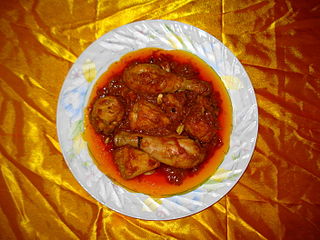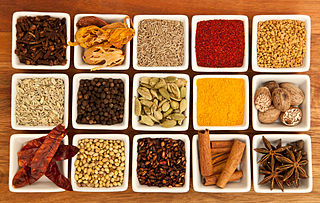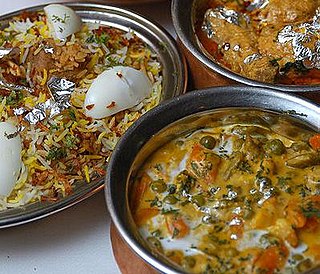
Pakistani cuisine can be characterized by a blend of various regional cooking traditions of the Indian subcontinent, Central Asia as well as elements from its Mughal legacy. The various cuisines are derived from Pakistan's ethnic and cultural diversity.

Korma is a dish originating in the Indian subcontinent, consisting of meat or vegetables braised with yogurt (dahi) or cream, water or stock, and spices to produce a thick sauce or glaze.

Haleem is a stew popular in the Middle East, Central Asia, and the Indian subcontinent. Although the dish varies from region to region, it always includes wheat or barley, and sometimes meat and/or lentils. Popular variations include keşkek in Turkey, Iran, Afghanistan, Tajikistan, Uzbekistan, Azerbaijan and northern Iraq; Hareesa in the Arab world and Armenia; Halim in Bangladesh and West Bengal, India; Khichra in Pakistan and India. Americans also have a similar dish called Farina.

Tamil cuisine is a cuisine native to the Tamil people who are native to the Indian state of Tamil Nadu and northern Sri Lanka. It is also the cuisine of the Tamil-speaking population of Karnataka, Kerala and Andhra Pradesh in India and of the Tamil communities of Singapore, Malaysia, and Indonesia.

Hyderabadi biryani is a variety of biryani from Hyderabad, India. It is prepared from rice using the dum method of cooking.

Penang cuisine is the cuisine of the multicultural society of Penang, Malaysia. Most of these cuisine are sold at road-side stalls, known as "hawker food" and colloquially as 'muckan carts'. Local Penangites typically find these hawker fares cheaper and easier to eat out at due to the ubiquitousness of the hawker stalls and that they are open for much of the day and night. Penang island. On February 22, 2013, Penang was ranked by CNN Travel as one of the top ten street food cities in Asia. Penang has also been voted by Lonely Planet as the top culinary destination in 2014.

The cuisine of Karnataka includes many vegetarian and non-vegetarian cuisines. It is one of the oldest surviving cuisines and traces its origin to the Iron Age. Ragi is mentioned in the historical works of the great poet Adikavi Pampa and in the ancient Sanskrit medical text Sushruta Samhita. The varieties of the Karnataka cuisine have drawn influence from and influenced the cuisines of neighbouring states like Tamil Nadu, Andhra Pradesh and Kerala.
Although the ingredients differ from one region to another, a typical Kannadiga Oota includes the following dishes in the order specified and is served on a banana leaf: Uppu (salt), Kosambari, Pickle, Palya, Gojju, Raita, Payasa (Kheer), Thovve, Chitranna, Anna (rice), and Tuppa (ghee).

Bhojpuri cuisine is a part of North Indian and Nepalese cuisine and a style of food preparation common amongst the Bhojpuri people living in the Bhojpuri region of Bihar and Uttar Pradesh. Bhojpuri foods are mostly mild and are less hot in term of spices used, but could be hotter and spicier according to individual preference. The food is tailor-made for Bhojpuri lifestyle in which the rural folk burn up a lot of calories in the fields. Bhojpuri people take pride in celebrating various festivals and religious rites with food; as a result, their food resembles the delicacies offered to deities.

Spiced rice is cooked rice where spices are added to give a distinct flavour. Spiced rice is common among the people of Dakshina Kannada and Udupi districts of Karnataka, and is seen in other parts of Asia.

Hyderabadi cuisine, also known as Deccani cuisine, is the native cooking style of the Hyderabadi Muslims, and began to develop after the foundation of the Bahmani Sultanate, and more drastically with the Qutb Shahi dynasty around the city of Hyderabad, promoting the native cuisine along with their own. Hyderabadi cuisine had become a princely legacy of the Nizams of Hyderabad State, as it began to further develop further on from there. It is an amalgamation of Mughal, Turkish, and Arabic along with the influence of the native Telugu and Marathwada cuisines. Hyderabadi cuisine comprises a broad repertoire of rice, wheat and meat dishes and the skilled use of various spices, herbs and natural edibles.

Cuisine of Uttar Pradesh is from the state of Uttar Pradesh(UP) located in Northern India. The Cuisine of UP has a large variety of dishes. The cuisine consists of both vegetarian and non-vegetarian dishes of different varieties. Being a large state, the cuisine of UP share lot of dishes and recipes with the neighboring states of Delhi, Uttarakhand, Haryana and Apart from native cuisine, Mughlai and Awadhi are two famous sub types of cuisine of the state.

Awadhi cuisine is a cuisine native to the city of Lucknow, which is the capital of the state of Uttar Pradesh in Northern India. It is very closely related to Bhojpuri cuisine of it neighboring region, Bhojpur. The cooking patterns of Lucknow are similar to those of Central Asia, the Middle East, and Northern India with the cuisine comprising both vegetarian and non-vegetarian dishes. The Awadh region has been greatly influenced by Mughal cooking techniques, and the cuisine of Lucknow bears similarities to those of Central Asia, Kashmir, Punjab and Hyderabad. The city is also known for its Nawabi foods.

Bihari cuisine is eaten mainly in Bihar, Jharkhand, Eastern Uttar Pradesh, Bangladesh, Nepal, Mauritius, South Africa, Fiji, some cities of Pakistan, Guyana, Trinidad and Tobago, Suriname, Jamaica, and the Caribbean, as these are the places where people originating from the state of Bihar are present. Bihari cuisine includes Bhojpuri cuisine, Maithil cuisine and Magahi cuisine. There is also a tradition of meat-eating, and fish dishes are especially common in the Mithila region of North Bihar due to the number of rivers, such as the Sone, Gandak and Ganges and Koshi. There are also numerous Bihari meat dishes, with chicken and mutton being the most common.

Wazwan(Kashmiri: وازِوان) is a multi-course meal in Kashmiri cuisine, the preparation of which is considered an art and a point of pride in Kashmiri culture and identity. Almost all the dishes are meat-based using lamb or chicken with few vegetarian dishes. It is popular throughout the Kashmir. Moreover, Wazwan is also served internationally at Kashmiri food festivals and reunions.

Nasi kebuli is an Indonesian style spicy steamed rice dish cooked in goat broth, milk, and ghee. It is popular among the Arab community in Indonesia and Betawi people in Jakarta. Nasi kebuli was influenced by Arab culture and its origin can be traced to Middle eastern cuisine, especially Yemeni Arabian influence or Kabsa, and also Indian cuisine influence.

Telugu cuisine is a cuisine of South India native to the Telugu people from the states of Andhra Pradesh and Telangana. Generally known for its tangy, hot and spicy taste, the cooking is very diverse due to the vast spread of the people and varied topological regions.

Karachi Cuisine refers to the food found mainly in the city of Karachi, Sindh, Pakistan. The cuisine of Karachi is strongly influenced by the city's Urdu speaking Muslims, also known as Muhajir population, who came from northern India and settled in Karachi after the independence of Pakistan in 1947. Most Urdu speaking Muslims have traditionally been based in Karachi, hence the city is known for Muhajir tastes in its cuisine. Urdu speaking Muslims maintained their old established culinary traditions, including variety of dishes and beverages.

Thalassery Cuisine refers to the distinct cuisine from Thalassery town of northern Kerala, that has blended in Arabian, Persian, Indian and European styles of cooking as a result of its long history as a maritime trading post.
Thalassery is known for its biryani. Unlike other biriyani cuisines Thalassery biryani uses Kaima/Jeerakasala rice instead of the usual basmati rice. The influence of Arabian/Mughal culture is evident, especially in the dishes of the Muslim community, although many have become popular among all communities.

Nasi minyak is a Sumatran dish from Indonesia of cooked rice with minyak samin (ghee) and spices. This rice dish is commonly associated with Palembang city, the capital of South Sumatra province. However, it is also common in neighboring Jambi as far north to Medan in North Sumatra. In a glimpse, nasi minyak looks and tastes slightly like nasi kebuli, this is because both rice dishes are influenced by Indian and Middle Eastern cuisines, as evidence in the use of ghee and certain spices. Bumbu spice mixture being used including cardamom, anise, clove, caraway, cinnamon, onion, garlic and curry powder.



















